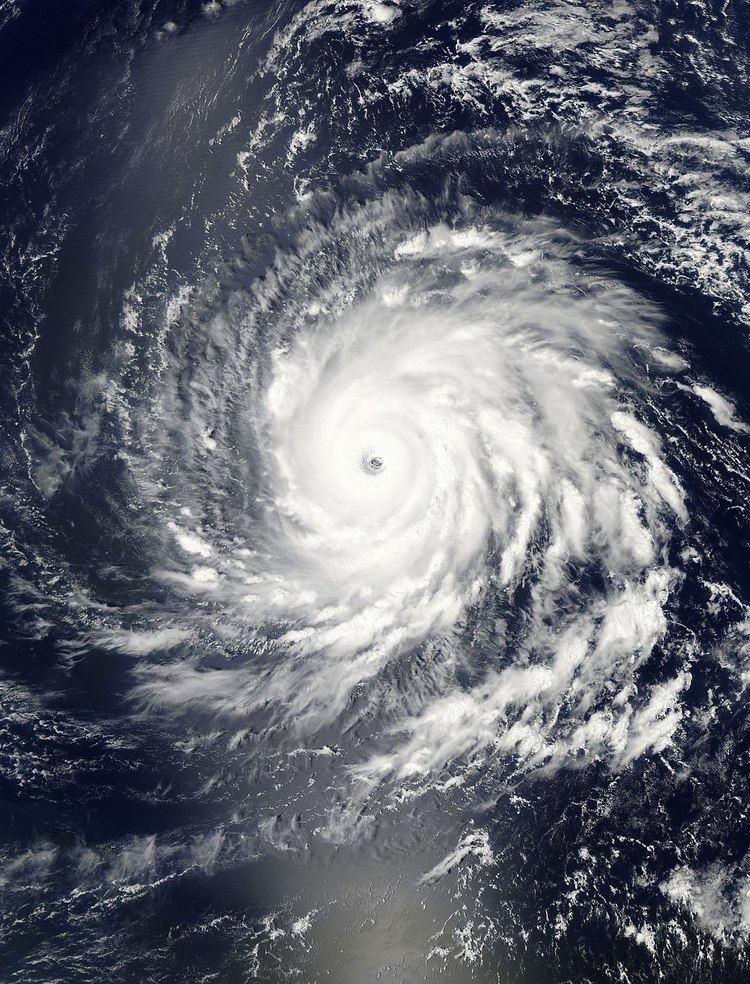 | ||
Category 4 hurricanes are tropical cyclones that reach Category 4 intensity on the Saffir-Simpson Hurricane Scale. Category 4 hurricanes that later attained Category 5 strength are not included in this list. The Atlantic basin includes the open waters of the Atlantic Ocean, the Caribbean Sea and the Gulf of Mexico. Category 4 is the second-highest hurricane classification category on the Saffir-Simpson Hurricane Scale, and storms that are of this intensity maintain maximum sustained winds of 113–136 knots (130–156 mph, 209–251 km/h). Based on the Atlantic hurricane database, 94 hurricanes have attained Category 4 hurricane status since 1851, the start of modern meteorological record keeping. Category 4 storms are considered extreme hurricanes. Hurricane Ike, which was a Category 4 storm, brought on a 24 ft storm surge, the third greatest storm surge ever recorded (after Hurricane Katrina and Hurricane Camille, respectively).
Contents
Statistics
Category 4 hurricanes have maximum sustained winds of 113–136 knots (130–156 mph, 209–251 km/h). "Sustained winds" refers to the average wind speed observed over one minute at a height of 10 meters (33 ft) above ground. Gust can be 30% higher than the sustained winds. Mobile homes and other buildings without fixed structures can be completely destroyed, and the lower floors of sturdier structures usually sustain major damage. In addition to the winds, the cyclones generally produce a storm surge of 13–18 feet (4–5.5 m) above normal, potentially causing major beach erosion. Heavy, irreparable damage and/or near complete destruction of gas station canopies and other wide span overhang type structures are also very common, and mobile and manufactured homes are often completely destroyed. Low-level terrain may be flooded well inland, as well. In addition, Category 4 hurricanes are very often Cape Verde type hurricanes. Cape Verde hurricanes are usually the strongest, and their track sometimes points them towards the United States, or other land.
Studies have shown that the number of Category 4 and 5 hurricanes nearly doubled in occurrence in from 1970 to 2004. Also, due to growing population in major coastal cities, many areas have become more vulnerable to strong hurricanes, especially categories 4 and 5.
Meteorological measurements
All of the storms listed in this analysis are listed in chronological order, but they also list the minimum central pressure and maximum sustained winds. Each of these meteorological readings are taken using a specific meteorological instrument. For modern storms, the minimum pressure measurements are taken by Reconnaissance Aircraft using dropsondes, or by determining it from satellite imagery using the Dvorak technique. For older storms, pressures are often incomplete, typically being provided by ship-reports or land-observations. None of these methods can provide constant pressure measurements; thus it is possible the only measurement occurred when the cyclone was at a lesser strength. Sustained winds are taken using an Anemometer at 10 meters (33 ft) above the ground.
Climatology
A total of 95 hurricanes in the Atlantic Ocean Basin, including the Gulf of Mexico and the Caribbean, have reached Category 4 status as their peak intensity. (Note that Category 4 storms that intensified later to Category 5 status are not included in this analysis.)
Most Category 4 hurricanes occur during September, with 51 storms occurring in that month. This coincides with the average peak of the Atlantic hurricane season, which occurs on September 10. Most Category 4 hurricanes develop in the warm waters of the Gulf of Mexico and the Caribbean Sea. Several Category 4 hurricanes are Cape Verde-type hurricanes. There have been no Category 4 hurricanes to form in either May or December, or in any other month outside the traditional bounds of the Atlantic hurricane season.
Listed in chronological order
All data listed is provided by the NHC best track, unless otherwise noted. Also, some pressure readings for the older storms may have been taken at a time other than the storm's peak intensity. Thus, some pressure readings might not be the minimum pressure.
Some pressure readings are unavailable due to scarce information.
1851–1900
In the years between 1851 and 1900, thirteen Category 4 storms are known to have occurred in the Atlantic Ocean. These numbers are limited by the observation techniques used prior to the use of satellite imagery in the 1960s.
1901–1950
Between 1901 and 1950, 29 Category 4 hurricanes formed in the Atlantic Basin.
1951–1975
In the years between 1951 and 1975, there were 23 Category 4 hurricanes in the Atlantic Ocean.
1976–2000
In the years between 1976 and 2000, 24 Category 4 hurricanes formed in the basin:
2001–Present
In the years between 2001 and the present time, 21 Category 4 hurricanes formed within the confines of the Atlantic Ocean. A dagger () denotes that the storm temporarily weakened below Category 4 intensity during the specified period of time.
Landfalls
The following hurricanes made landfall at some location at any strength Due to inaccuracies in data, tropical depression landfalls are not included. Several of these storms weakened slightly after attaining Category 4 status as they approached land; this is usually a result of dry air, shallower water due to shelving, cooler waters, or interaction with land.
